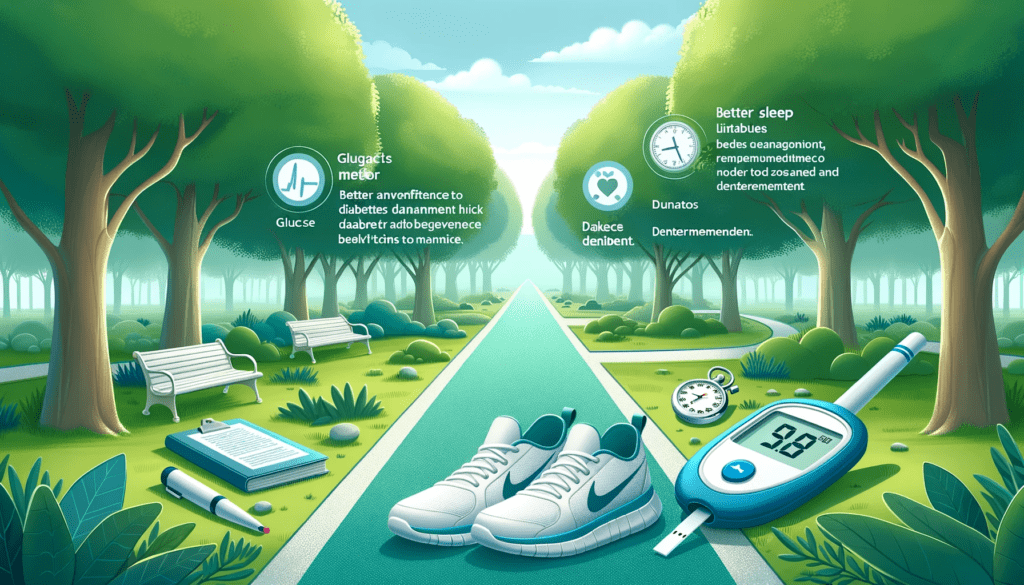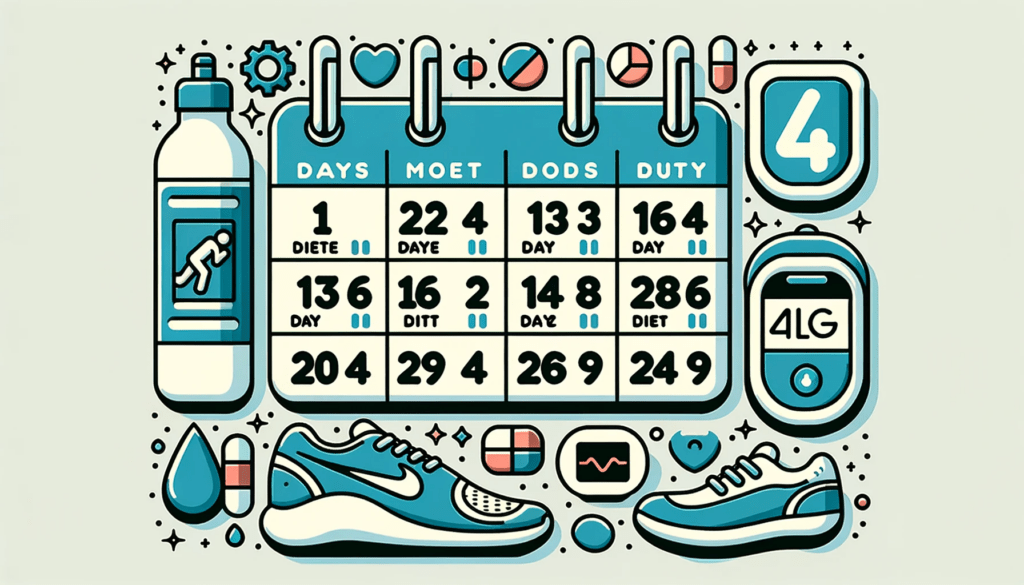Best Time to Walk for Diabetes: Key US Strategies

Understanding the impact of walking on diabetes management is crucial. One key aspect to consider is the best time to walk for optimal results. Walking after meals, particularly 60 to 90 minutes later, can aid digestion and lower blood sugar levels, reducing the risk of type 2 diabetes. Best Time to Walk for Diabetes: Key US Strategies
Even a few minutes of gentle walking can have a positive effect. Besides improving blood sugar control, walking offers additional advantages such as better sleep, improved mood, weight loss support, and enhanced overall well-being. Personalizing the walking routine according to physical limitations is essential, as is consulting with a healthcare professional. To ensure safety, monitoring blood sugar levels, wearing appropriate footwear, staying hydrated, and carrying snacks are recommended.
Walking with a companion can add motivation and enjoyment to the experience. A four-week walking plan can be beneficial for maintaining stable blood sugar levels. Ultimately, integrating regular walking into diabetes management can contribute to better health outcomes.


-
Understanding the Impact of Walking on Diabetes Management - Best Time to Walk for Diabetes: Key US Strategies
- The Fundamental Role of Walking in Diabetes Management
- Post-Meal Strolls: Aiding Digestion and Regulating Blood Sugar
- The Wide-Ranging Benefits for Type 2 Diabetics
- Personalization and Professional Consultation for Safe Walking Routines
- Importance of Monitoring and Understanding Blood Sugar Levels
- Ensuring Comfort and Safety During Walks
- Enhancing the Walking Experience: Companionship and Safety Measures
- Instituting a Comprehensive Walking Plan for Holistic Health
- Beyond Blood Sugar: Additional Benefits of Walking
-
The Importance of Timing: The Best Time to Walk for Diabetes - Best Time to Walk for Diabetes: Key US Strategies
- Ideal Walking Time for Diabetic Management
- Additional Benefits for Obesity Management
- Psychological and Sleep Advantages
- Tailoring Your Walking Schedule
- Consultation and Professional Advice
- Consistency and Monitoring: The Keys to Success
- Safety and Comfort During Your Walk
- Holistic Benefits of Timed Walking
- Walking After Meals: A Simple Step Towards Better Blood Sugar Levels - Best Time to Walk for Diabetes: Key US Strategies
- The Benefits of Walking for People with Type 2 Diabetes
- Walking for Weight Loss: How It Can Help Manage Diabetes - Best Time to Walk for Diabetes: Key US Strategies
- Walking for Mental Health: The Positive Effects on Diabetes Management - Best Time to Walk for Diabetes: Key US Strategies
- Adapting Your Walking Routine: Personalizing it to Fit Your Physical Limitations - Best Time to Walk for Diabetes: Key US Strategies
- Talk to Your Doctor: The Importance of Medical Guidance in Your Walking Routine - Best Time to Walk for Diabetes: Key US Strategies
- Monitoring Blood Sugar: Before and After Walking for Diabetes
- Choosing the Right Shoes and Staying Hydrated: Essential Factors for a Safe Walk
- Walking with Company: The Advantages of Walking with a Companion
- Managing Diabetes with a Four-Week Walking Plan: Tips for Stabilizing Blood Sugar Levels
- Integrating Walking into Your Diabetes Management: The Bottom Line
- Footer: All Rights Reserved
Understanding the Impact of Walking on Diabetes Management - Best Time to Walk for Diabetes: Key US Strategies
The Fundamental Role of Walking in Diabetes Management
- Walking plays a crucial role in managing diabetes, offering numerous benefits for individuals with this condition. By engaging in regular walking routines, individuals can effectively control their blood sugar levels and improve their overall health.
Post-Meal Strolls: Aiding Digestion and Regulating Blood Sugar
- Walking after meals has been found to have a significant impact on digestion and blood sugar regulation. Just 60 to 90 minutes after eating, a leisurely walk can help reduce sugar levels in the bloodstream. Even a short walk can yield positive results.
The Wide-Ranging Benefits for Type 2 Diabetics
- For those with type 2 diabetes, incorporating walking into a daily routine can lead to various advantages. From better weight management to improved cardiovascular health, regular walking can positively impact overall diabetes management.
Personalization and Professional Consultation for Safe Walking Routines
- Personalizing walking routines based on individual physical limitations is crucial. Consulting with a healthcare professional prior to starting a walking regimen is highly recommended, as they can provide tailored advice to ensure safety and optimal benefits.
Importance of Monitoring and Understanding Blood Sugar Levels
- Monitoring blood sugar levels before and after walking is important. This helps individuals understand how walking affects their specific condition and may require adjustments to diet or other factors to maintain stable blood sugar levels.
Ensuring Comfort and Safety During Walks
- When walking, choosing appropriate footwear is essential for comfort and support, while staying adequately hydrated is critical for overall well-being during exercise. It's also wise to carry snacks, especially for individuals susceptible to hypoglycemia.
Enhancing the Walking Experience: Companionship and Safety Measures
- By walking with a companion, individuals can stay motivated and enhance the overall walking experience. Additionally, wearing a medical identification bracelet can provide vital information in case of emergencies.
Instituting a Comprehensive Walking Plan for Holistic Health
- Walking regularly, as part of a comprehensive diabetes management plan, can have a positive impact on physical and mental health. Incorporating a four-week walking plan and aiming for at least 150 minutes of moderate aerobic exercise each week can help stabilize blood sugar levels and promote overall well-being.
Beyond Blood Sugar: Additional Benefits of Walking
- The benefits of walking go beyond controlling blood sugar levels. It also aids in weight loss, improves cardiovascular health, and contributes to better mental well-being. By understanding these benefits, individuals can make informed decisions about incorporating walking into their diabetes management routine.
All Rights Reserved
The Importance of Timing: The Best Time to Walk for Diabetes - Best Time to Walk for Diabetes: Key US Strategies
When it comes to managing diabetes, timing plays a crucial role in optimizing the benefits of walking. Knowing the best time to walk can have a significant impact on your blood sugar levels and overall health.
Ideal Walking Time for Diabetic Management
- Research suggests that walking 60 to 90 minutes after meals is the most effective timing for individuals with diabetes. This post-meal window is when our bodies are actively digesting food, and walking during this time can aid in digestion and help lower blood sugar levels. Just a few minutes of gentle walking can make a noticeable difference.
Additional Benefits for Obesity Management
- If you're dealing with obesity, standing up and walking after meals can have even more promising results. Not only does it help control blood sugar levels, but it also boosts metabolism and aids in weight management.
Psychological and Sleep Advantages
- Aside from the immediate physiological benefits, walking after dinner also releases serotonin, a neurotransmitter that promotes better sleep and improves mood. It's a win-win for overall well-being.
Tailoring Your Walking Schedule
- However, it's important to emphasize that the best time to walk may vary from person to person. Factors such as personal preferences, individual needs, and physical limitations should be taken into account when determining the optimal time to incorporate walking into your diabetes management routine.
Consultation and Professional Advice
- Consulting with your healthcare professional is strongly recommended before embarking on any new exercise regimen, including walking. They can provide tailored advice based on your specific health condition.
Consistency and Monitoring: The Keys to Success
- Remember, the key is consistency. Strive to walk at a brisk pace for at least 30 minutes on as many days as possible. Monitoring blood sugar levels before and after the walk is essential to better understand how your body responds.
Safety and Comfort During Your Walk


- To ensure a safe and comfortable walk, choose suitable walking shoes and wear proper socks. Stay hydrated throughout the walk, and consider carrying snacks in case of low blood sugar episodes. Walking with a companion and wearing a medical identification bracelet are additional precautions that can contribute to a peace of mind.
Holistic Benefits of Timed Walking
- By finding the best time to walk for your diabetes management and incorporating it into a personalized routine, you can reap the benefits not only for controlling blood sugar but also for overall weight management, cardiovascular health, and enhanced well-being.
Walking After Meals: A Simple Step Towards Better Blood Sugar Levels - Best Time to Walk for Diabetes: Key US Strategies
Walking after meals can be a simple but effective strategy to improve blood sugar levels for individuals with diabetes. This post-meal walking routine has shown promising results in regulating glucose metabolism.
By engaging in a leisurely stroll or brisk walk approximately 60 to 90 minutes after eating, you can enhance digestion, lower blood sugar levels, and reduce the risk of developing type 2 diabetes. This timing allows the body to utilize the energy from the meal and helps prevent blood sugar spikes.
- Engage in a 15 to 30-minute walk at a comfortable pace
- Enjoy the benefits of increased insulin sensitivity and improved glucose control
- Experience the positive impact on weight management and overall well-being
- Improve digestion and reduce the risk of post-meal fatigue
Remember to monitor your blood sugar levels before and after walking to assess the impact on your body. In some cases, consuming a small amount of carbohydrates before walking may be necessary to stabilize blood sugar levels.
Consult with your healthcare provider to discuss the best walking routine and any potential precautions based on your individual needs. Remember, walking after meals can be a simple yet powerful step towards better blood sugar control and overall diabetes management.
The Benefits of Walking for People with Type 2 Diabetes
Walking is an excellent form of exercise for individuals with type 2 diabetes, offering a range of health benefits. Incorporating regular walks into your routine can help improve blood sugar control, lower the risk of complications, and promote overall well-being.
Here are several key benefits of walking for people with type 2 diabetes:
- Improved Blood Sugar Control: Walking helps your body utilize insulin more effectively, leading to better blood sugar management.
- Weight Management: Walking aids in weight loss or maintenance, which is crucial for managing diabetes and enhancing overall health.
- Heart Health: Regular walks contribute to a healthier heart by reducing the risk of cardiovascular diseases associated with diabetes.
- Stress Reduction: Walking promotes relaxation and reduces stress levels, which is beneficial for diabetes management, as stress can impact blood sugar control.
- Improved Insulin Sensitivity: Walking helps enhance your body's sensitivity to insulin, allowing for better blood sugar regulation.
- Increased Energy Levels: Engaging in regular walking can boost energy levels and combat feelings of fatigue often associated with diabetes.
- Enhanced Mental Health: Walking releases endorphins, known as "feel-good" hormones, which can improve mood and enhance overall mental well-being.
These benefits highlight the positive impact that regular walking can have on diabetes management. It is always important to consult with your healthcare provider before starting a new exercise routine, including walking, to ensure it aligns with your specific needs and limitations.
Walking for Weight Loss: How It Can Help Manage Diabetes - Best Time to Walk for Diabetes: Key US Strategies
When it comes to managing diabetes, walking can be a powerful tool, not just for controlling blood sugar levels but also for weight loss. Shedding extra pounds can have significant benefits for individuals with diabetes by improving insulin resistance and overall health.
Engaging in regular walking routines can help create a calorie deficit, which is essential for weight loss. Walking is a low-impact exercise that can be easily incorporated into daily activities. By increasing physical activity levels, walking contributes to burning calories and promoting weight loss.
In addition to weight management, walking offers other advantages, such as reducing the risk of cardiovascular disease, improving heart health, and boosting overall fitness. As people with diabetes often face a higher risk of heart-related issues, incorporating walking into their routine can have a positive impact on their long-term health outcomes.
- By walking regularly, individuals with diabetes can:
- Manage their weight effectively.
- Improve insulin sensitivity and glucose control.
- Enhance cardiovascular health.
- Experience increased energy levels.
To maximize the benefits of walking for weight loss and diabetes management, it is important to establish a consistent routine and gradually increase intensity. Consultation with a healthcare professional is crucial to tailor the walking regimen to individual needs and ensure safety.
Walking for Mental Health: The Positive Effects on Diabetes Management - Best Time to Walk for Diabetes: Key US Strategies
Engaging in regular walking not only benefits physical health but also plays a crucial role in promoting mental well-being for individuals managing diabetes. Walking serves as a therapeutic activity that can help reduce stress and anxiety, which are common challenges faced by those with diabetes. The rhythmic motion of walking, combined with fresh air, can have a calming effect on the mind, allowing individuals to lower their stress levels and improve their overall mental health.
Furthermore, walking triggers the release of endorphins, also known as the "feel-good" hormones, in the brain. These endorphins act as natural mood boosters, helping individuals maintain a positive outlook and improve their emotional state. By incorporating regular walks into their routine, individuals can experience a sense of empowerment and control over their diabetes management, leading to increased confidence and reduced feelings of depression.
Additionally, walking provides an opportunity for social interaction. Connecting with others while walking, whether it be a friend, family member, or a support group, can have a significant impact on mental well-being. Engaging in conversations, sharing experiences, and receiving encouragement during walks can provide emotional support and a sense of belonging, creating a positive mindset and motivation to continue managing diabetes effectively.
In conclusion, walking not only improves physical health and blood sugar management but also has positive effects on mental health for individuals with diabetes. By making walking a regular part of their routine, individuals can experience reduced stress and anxiety levels, boosted mood, and a sense of community, all of which contribute to overall well-being and better diabetes management.
Adapting Your Walking Routine: Personalizing it to Fit Your Physical Limitations - Best Time to Walk for Diabetes: Key US Strategies
When it comes to managing diabetes through walking, it's crucial to adapt your routine to suit your individual physical limitations. Everyone's body is unique, and what works for one person may not work for another. By personalizing your walking routine, you can ensure that it aligns with your capabilities and helps you manage your condition effectively.
Here are some tips to help you tailor your walking routine:
- Start slow: If you're new to walking or have physical limitations, it's important to start at a comfortable pace. Begin with short walks and gradually increase the duration and intensity over time.
- Listen to your body: Pay attention to any discomfort or pain during your walks. If something doesn't feel right, consult with your doctor or a physical therapist to address the issue and adjust your routine accordingly.
- Incorporate intervals: If you find it challenging to walk continuously, consider incorporating intervals of walking and rest. This can help you build endurance and gradually increase your walking duration.
- Use proper aids: Depending on your physical limitations, you may benefit from using assistive devices such as walking poles or braces. These aids can provide added stability and support while walking.
- Join a group or seek support: Walking with others who have similar physical limitations can provide motivation and encouragement. Look for local walking groups or consider joining diabetes support communities.
Remember, the goal is to find a walking routine that works for you and allows you to manage your diabetes effectively. By adapting your routine to fit your physical limitations, you can enjoy the benefits of walking while staying within your comfort zone.
Talk to Your Doctor: The Importance of Medical Guidance in Your Walking Routine - Best Time to Walk for Diabetes: Key US Strategies
When incorporating walking into your diabetes management, it is crucial to consult with your doctor. Seeking medical guidance ensures that your walking routine is tailored to your specific needs and limitations.
Your doctor can provide valuable insights into the best strategies to optimize your walking routine for diabetes. They can help determine the most suitable time to walk, taking into account factors such as medication schedules, meal timing, and individual blood sugar levels.
Additionally, your doctor can assess your overall health and recommend any necessary adjustments to your walking regimen. They can offer guidance on the duration, intensity, and frequency of your walks based on your physical condition.
Regular check-ups with your doctor also provide an opportunity to monitor your progress and address any concerns or challenges you may encounter along the way. They can help you track changes in your blood sugar levels, adjust your medication if needed, and provide ongoing support throughout your diabetes management journey.
Remember, your doctor is your ally in optimizing your walking routine for diabetes management. Their expertise and guidance are invaluable in ensuring that you engage in safe and effective physical activity that complements your overall treatment plan.
Monitoring Blood Sugar: Before and After Walking for Diabetes


Monitoring blood sugar levels before and after walking is crucial for individuals with diabetes. This helps track the impact of physical activity on glucose levels and ensures safety during exercise. Before starting a walk, it is advisable to measure blood sugar to establish a baseline. This baseline measurement provides insight into the current state of blood sugar control.
After completing the walk, it is essential to monitor blood sugar levels once again. This post-walk measurement allows individuals to assess how their body responded to the physical activity. It is important to watch for any fluctuations in blood sugar levels and take appropriate actions if they are too high or too low.
Regular monitoring of blood sugar levels before and after walking helps individuals understand how their body reacts to exercise and how it affects their diabetes management. This information can guide adjustments to medication, diet, or walking routine to maintain optimal blood sugar control. Remember, consistency in monitoring blood sugar levels is key to successful diabetes management.
Choosing the Right Shoes and Staying Hydrated: Essential Factors for a Safe Walk


When it comes to walking for diabetes management, two important factors to consider are choosing the right shoes and staying hydrated. These may seem like small details, but they can make a significant difference in ensuring a safe and comfortable walk.
- Shoe Selection: The right shoes provide proper support, cushioning, and stability, reducing the risk of foot injuries. Opt for walking shoes that fit well, have a supportive sole, and offer adequate room for your toes. Consider consulting with a shoe specialist to find the best option for your feet.
- Hydration: Staying hydrated is crucial during any physical activity, including walking. Dehydration can impact your performance and overall well-being. Remember to drink water before, during, and after your walk. Carry a water bottle with you, especially on longer walks or when the weather is hot and humid.
By choosing the right shoes, you can minimize the risk of foot problems and discomfort. Additionally, staying hydrated ensures optimal bodily function and helps prevent dehydration-related complications. Prioritize these essential factors to enjoy a safe and effective walk for diabetes management.
Walking with Company: The Advantages of Walking with a Companion


Walking with a companion can bring numerous benefits to your diabetes management journey. Here are a few advantages:
- Increased Motivation: Having someone to walk with can provide the extra motivation you need to stick to your walking routine. It keeps you accountable and makes the activity more enjoyable.
- Improved Safety: Walking with a companion ensures that you have someone by your side in case of any unforeseen circumstances like feeling unwell or experiencing low blood sugar levels.
- Social Interaction: Walking with a companion allows for meaningful conversations and companionship, reducing feelings of loneliness and enhancing your overall mental well-being.
- Sharing Successes and Challenges: Having a walking partner enables you to share your achievements and challenges related to diabetes management. It creates a support system that can offer valuable advice and encouragement.
Remember, finding a suitable walking companion can be as simple as reaching out to a friend, family member, or local walking group. Together, you can embark on this journey towards better health and diabetes management.
Managing Diabetes with a Four-Week Walking Plan: Tips for Stabilizing Blood Sugar Levels


Achieving stable blood sugar levels is crucial for managing diabetes effectively. Implementing a four-week walking plan can provide numerous benefits and help stabilize blood sugar levels. Here are some essential tips to consider:
- Gradual Progression: Start with shorter walks and gradually increase the duration and intensity to avoid overexertion.
- Consistency: Stick to a regular walking schedule, aiming for at least 150 minutes of moderate aerobic exercise per week.
- Mindful Monitoring: Before and after each walk, monitor your blood sugar levels to understand how walking affects your body and adjust as needed.
- Hydration: Stay properly hydrated during walks, as dehydration can impact blood sugar levels.
- Preparation: Choose comfortable walking shoes and wear suitable clothing to enhance your walking experience and minimize any discomfort.
- Nutrition: Depending on your blood sugar levels, consider consuming a light snack or carbs before walking to maintain optimal glucose levels.
- Walking Buddy: Find a walking companion who shares similar fitness goals and diabetes management needs to increase motivation and enjoyment.
- Adjustments: Adapt your walking plan based on your fitness level, physical limitations, and available time slots. Prioritize consistency over intensity.
By incorporating these tips into your four-week walking plan, you can effectively stabilize blood sugar levels, improve overall diabetes management, and experience the various health benefits that walking offers beyond glucose control. Remember to consult with your healthcare professional before starting any new exercise routine.
Integrating Walking into Your Diabetes Management: The Bottom Line


When it comes to managing diabetes, incorporating regular walking into your routine can have a profound impact on your overall health. Walking offers a multitude of benefits, including improved blood sugar control, weight management, and enhanced mental well-being.
To fully integrate walking into your diabetes management plan, consider the following:
- Set achievable goals: Start with shorter walks and gradually increase the duration and intensity over time.
- Stay consistent: Aim for at least 150 minutes of moderate aerobic exercise, like brisk walking, every week.
- Monitor your blood sugar levels: Regularly check your levels before and after walking to understand how it affects your body.
- Adapt and personalize: Modify your walking routine to accommodate any physical limitations or fitness levels.
- Consult with your healthcare provider: Before starting any exercise program, discuss your plans with your doctor to ensure it aligns with your specific needs.
Remember, integrating walking into your diabetes management is not a one-size-fits-all approach. Fine-tune your routine to suit your preferences and listen to your body's cues. By incorporating walking into your daily life, you can take control of your diabetes and improve your overall well-being.
All content and rights related to this article on the best time to walk for diabetes are reserved. The information provided is meant for informational purposes only and should not be considered as medical advice. It is important to consult with a healthcare professional before making any changes to your diabetes management routine or starting a new exercise program.
While every effort has been made to ensure the accuracy and reliability of the information presented, we do not guarantee its completeness or suitability for any specific individual's circumstances. The content of this article may not be reproduced, distributed, or used in any form without prior written consent.
This article is part of a comprehensive guide on managing diabetes through exercise and lifestyle modifications. Please refer to the other sections of the guide for further information on topics such as the impact of walking on blood sugar levels, the benefits of walking for weight loss, and the importance of personalized walking routines.
Thank you for visiting our website and remember to always prioritize your health and well-being when making decisions about your diabetes management.


